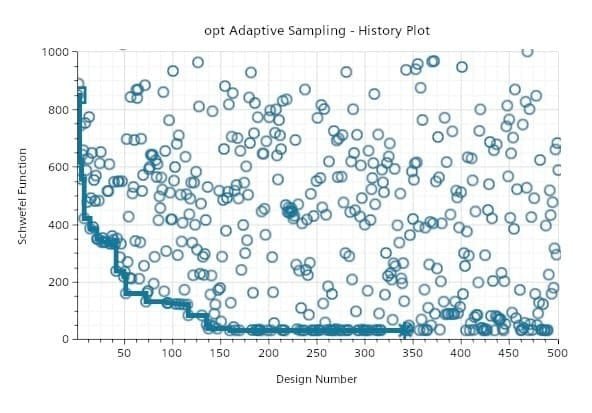An Adaptive Sampling study in Simcenter STAR-CCM+ intelligently characterizes the design space based on user-defined goals. It has been introduced in Simcenter HEEDS recently and is now, with version 2402, available in Simcenter STAR-CCM+ as well. Unlike traditional Design of Experiments (DOE) studies which distributes sample points mainly on edges or corners of the design space, adaptive sampling dynamically adjusts the sampling strategy to achieve the best possible coverage of the design space within a specified number of evaluations.
Understanding Adaptive Sampling
The adaptive sampling process is iterative and efficient. It starts with an initial set of design points, either provided by the user as seeds or generated using the Latin Hypercube method if no seeds are specified. These initial points serve as the foundation for further exploration.
As the study progresses, the adaptive sampling algorithm intelligently selects additional design points based on the specified Adaptive Strategy. This strategy guides the algorithm in focusing on areas of interest within the design space, such as regions with significant changes in responses or areas where optimal designs are likely to be found.
Testing the Adaptive Sampling
A typical test case for design exploration is the Schwefel function. It is a complex function, with many local optima, straight forward to evaluate and easy to plot.
f(textbf{x})=418.9829d – displaystylesum_{i=1}^{d} x_i sin (sqrt{|x_i|})
In two dimensions, Schwefel´s function has known global minimum of zero at x_1=x_2=420.9687 . However, it has a local minimum in the point where one element is 302.5232 and the others are 420.9687. It is rather far from the global minimum, so there is a chance that an algorithm will miss the global minimum.

Let´s test the new Adaptive Sampling method in Simcenter STAR-CCM+ by defining Schwefel´s function in a simulation, simply as an expression report based on 2 parameters. We can use this simulation in a Design Manager project and compare 2 Design exploration methods which both require the Intelligent Design Exploration license (a license free randomized sampling is tested here):
- Latin Hypercube sampling with 150 design evaluations
- Adaptive Sampling reusing 50 first designs of a previous Latin Hypercube study and computing 100 new designs using adaptive sampling with prioritized local region of interest.

Both methods cover the design space well. However, the distribution of design points from the Adaptive Sampling provides somewhat better coverage in extrema regions, seen in the figure above. Although this comparison is somehow biased, a more sophisticated evaluation is given from calculated surrogates.
The Cross V(alidation) residual of a design is the difference between the actual response value and the response value predicted by the reduced surrogate fit according to the cross-validation scheme specified. The value has the same unit as the study response for which the surrogate is calculated. The average error of the Cross V(alitation) is 26% of Schwefel´s functions mean value for the Latin Hypercube sampling. While the Cross V average error is 9% for the Adaptive sampling approach.
The surrogates can be used in an optimization to find the global minimum of Schwefel´s function. Evaluating the performance of a design on a surrogate does not require noteworthy computational resources such that 500 evaluations can be done in a couple of seconds. Here we can find the minimum for the surrogate based on the pure Latin Hypercube sampling and for the combination of Latin Hypercube and Adaptive sampling as follows.
| X1 | X2 | F(x) | |
| Latin Hypercube | 426,32 | 427,57 | 106,58 |
| Adaptive Sampling | 423,85 | 429,02 | 30,91 |
Both approaches miss the absolute value of the global minimum. But it is clear that the Adaptive Sampling provides a better basis to build a surrogate model with the same resources. The surrogate model is capable of finding lower values of the objective function and deviates less from the location of the global minimum. The surrogate method based on the Latin Hypercube sampling converges prematurely after around 120 evaluations. However, none of the approaches ended up in a local minimum.


Benefits Over Traditional DOE
Compared to traditional DOE studies, adaptive sampling offers several advantages:
- Faster Convergence: Adaptive sampling is faster at converging towards a precise description of the design space of interest. By dynamically adjusting the sampling strategy, it efficiently explores the design space, requiring fewer evaluations to achieve comparable results.
- Precise Surrogate Generation: In the context of surrogate modeling, adaptive sampling automatically determines the best fit surrogate properties. This leads to the creation of surrogates with precise global descriptions of the design space or localized descriptions of specific areas where responses exhibit significant variations.
- Targeted Exploration: Adaptive sampling allows for targeted exploration of specific areas within the design space. It allows you to focus on regions where critical design decisions need to be made or where responses exhibit complex behavior.
The flexibility and efficiency of adaptive sampling make it suitable for a wide range of applications. However, it is most effective combined with surrogate modelling.
The described methods, the Latin Hypercube and Adaptive Sampling, as well as the Surrogate Model, are features of the Intelligent Design Exploration license. If you like to to know more about these features or want to test the Intelligent Design Exploration in Simcenter STAR-CCM+, please feel free to contact us at support@volupe.com.
The Author
Florian Vesting, PhD
Contact: support@volupe.com
+46 768 51 23 46
